TYPES of WORD-FORMATION highly-productive (affixation, conversion and similar

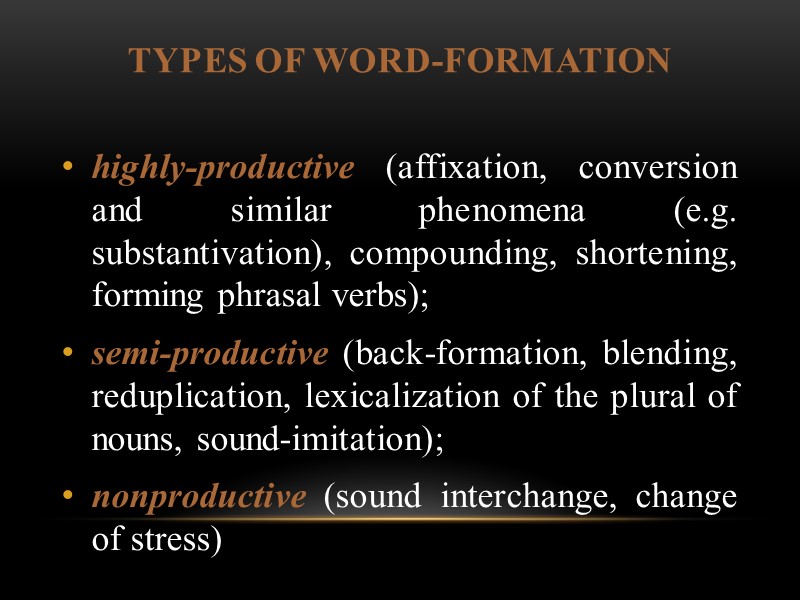
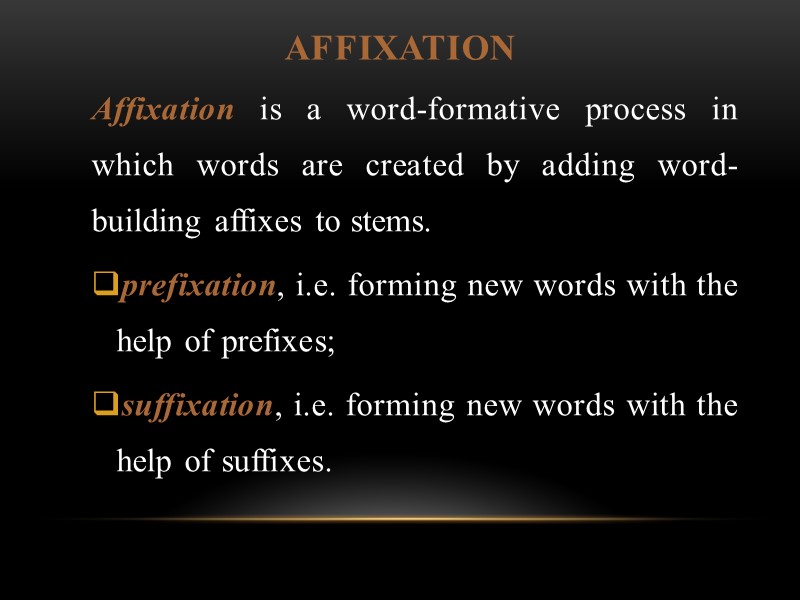
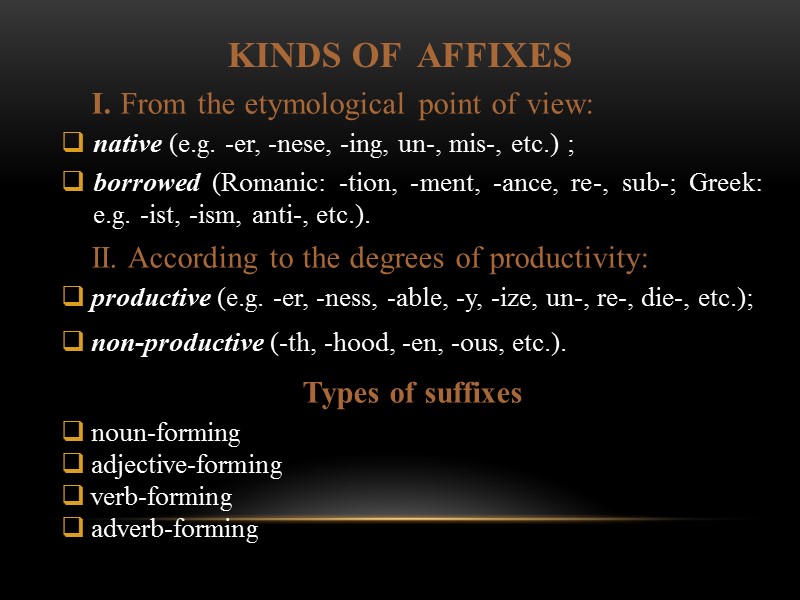
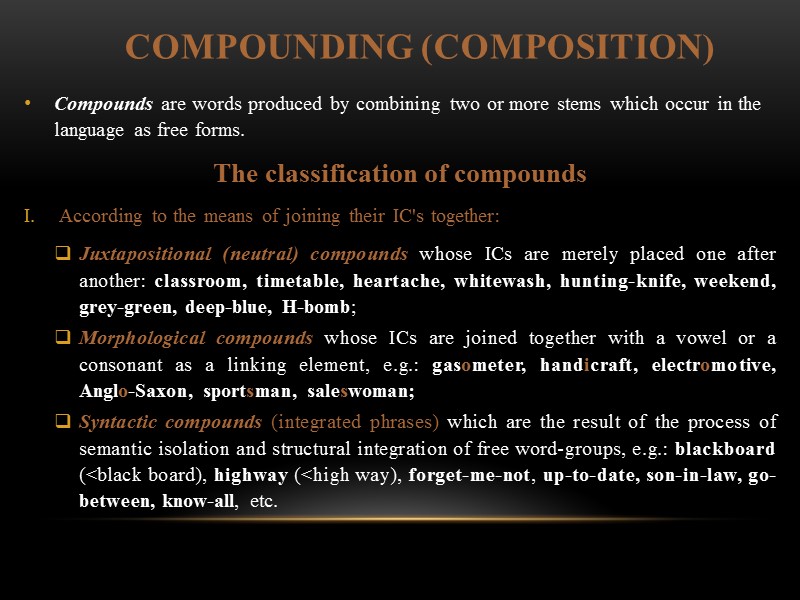
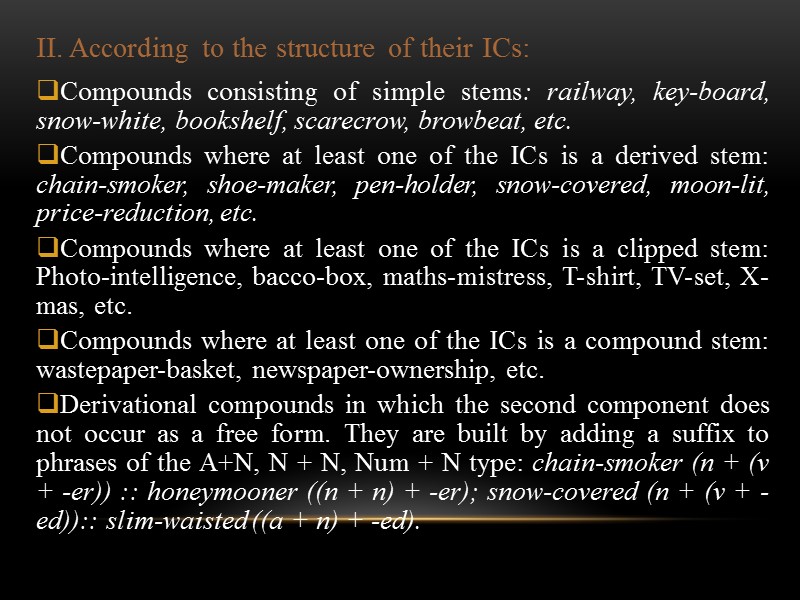
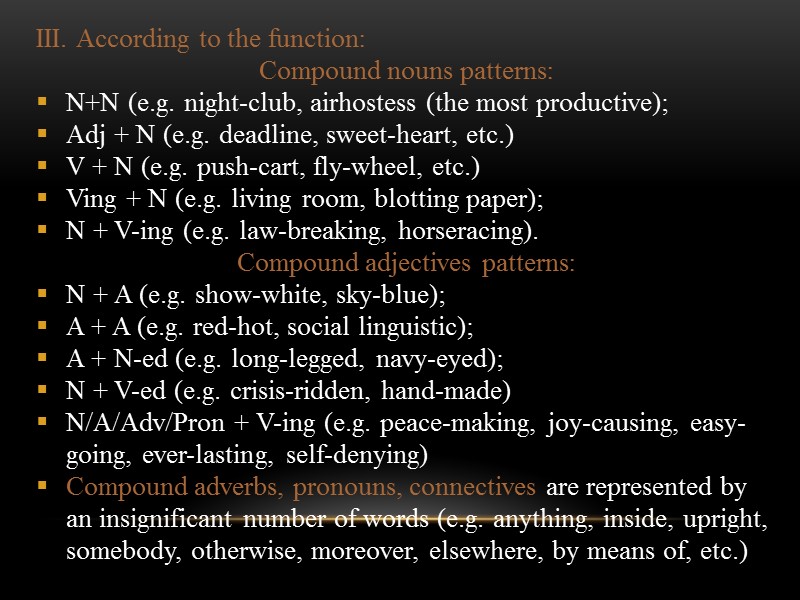
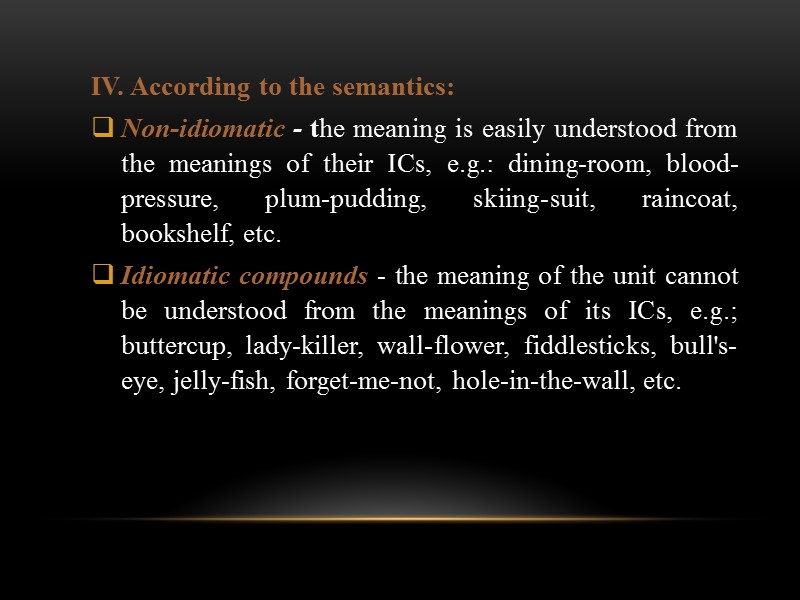
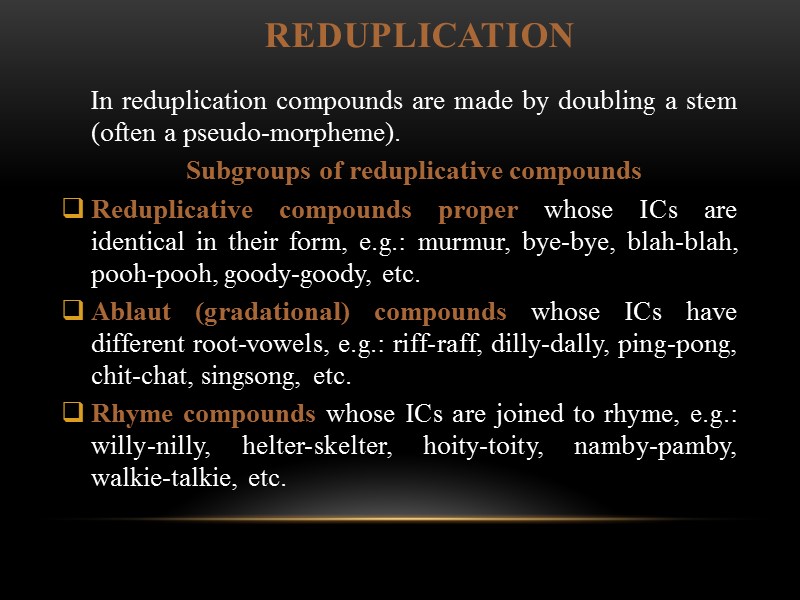
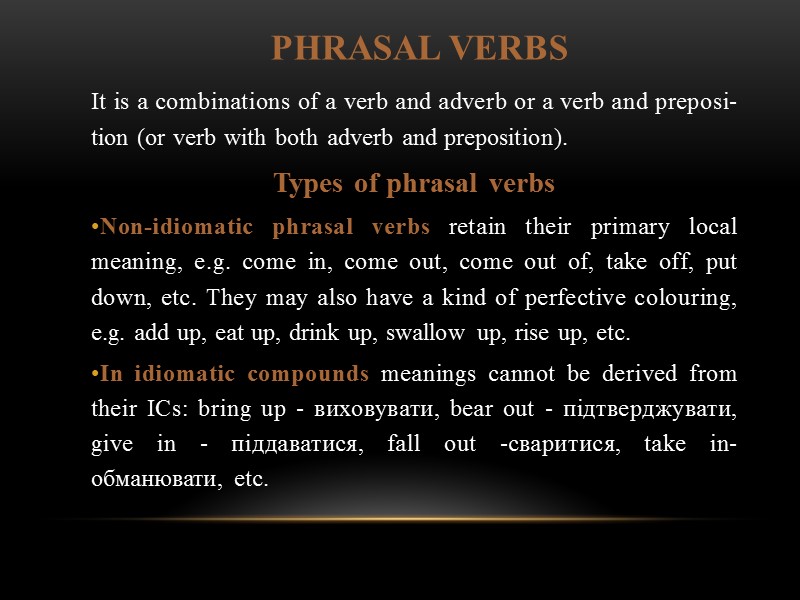
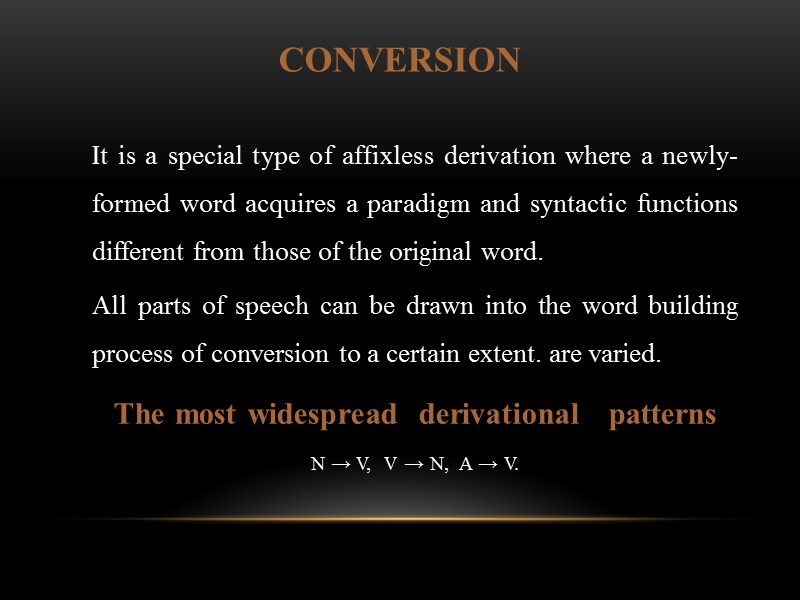
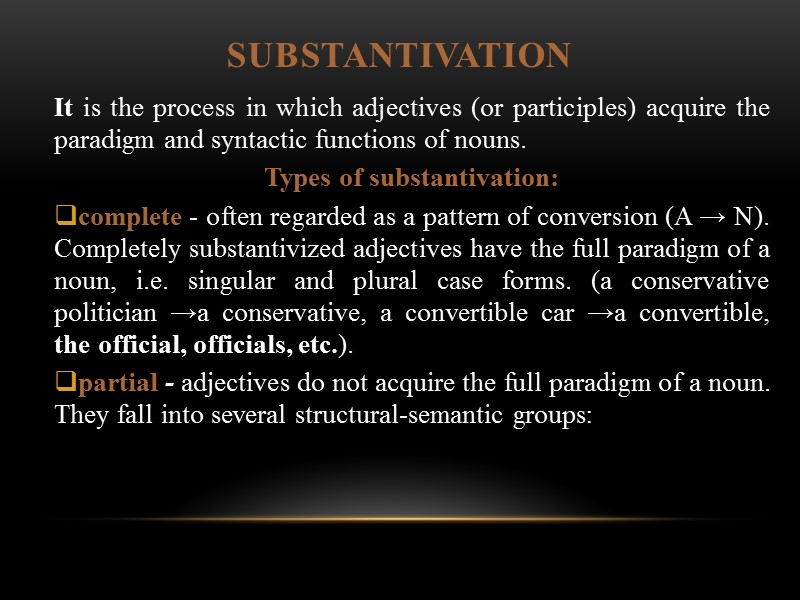
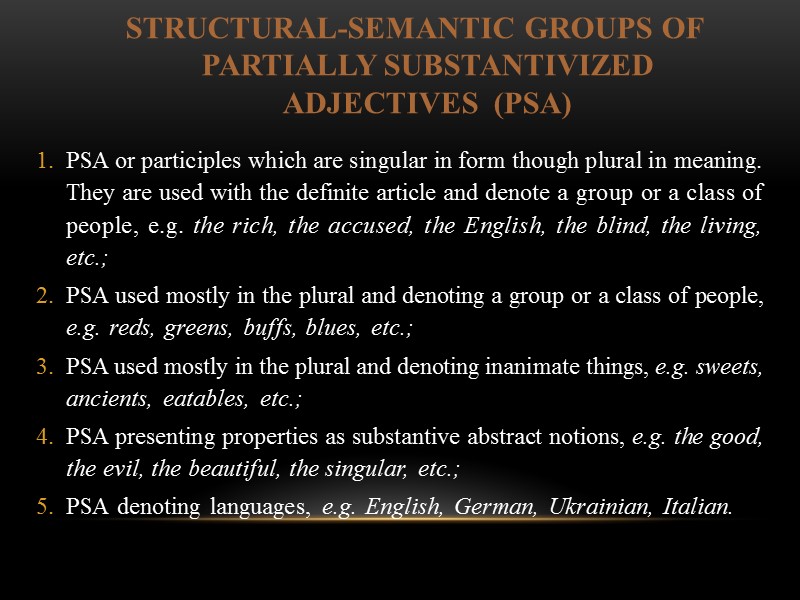
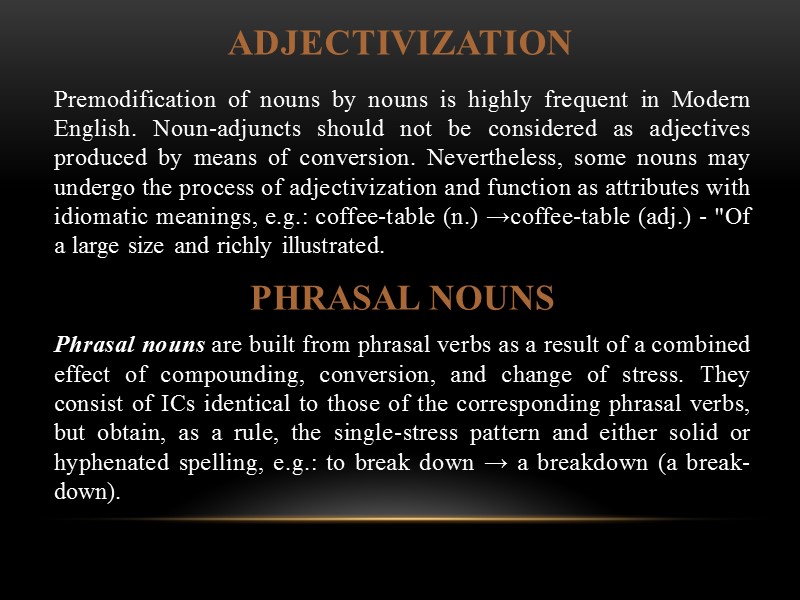
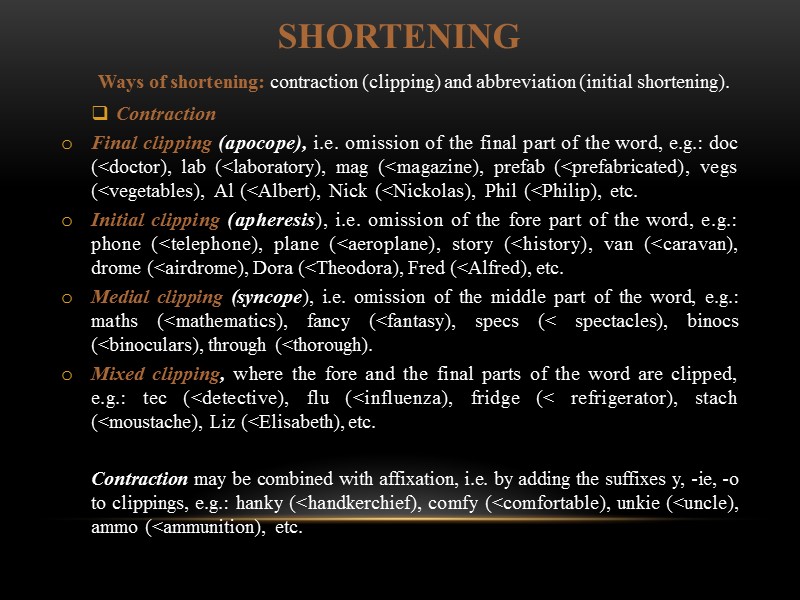
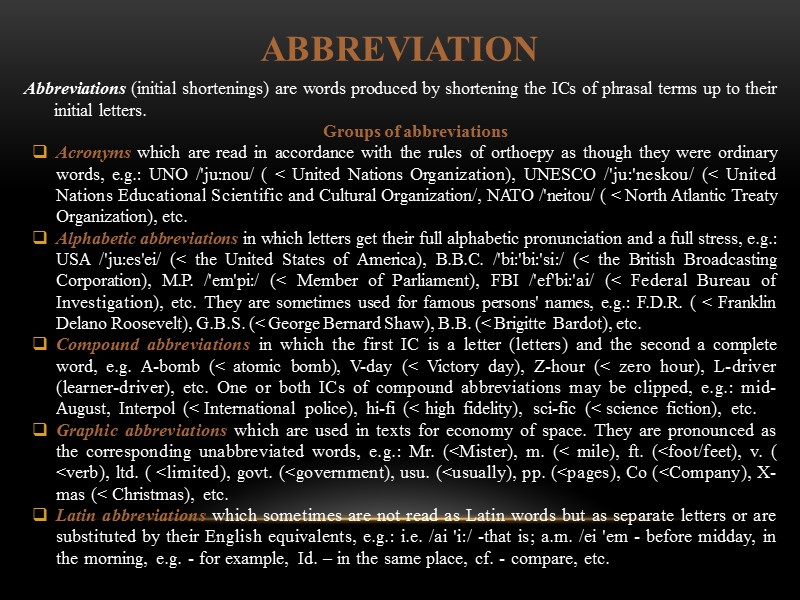
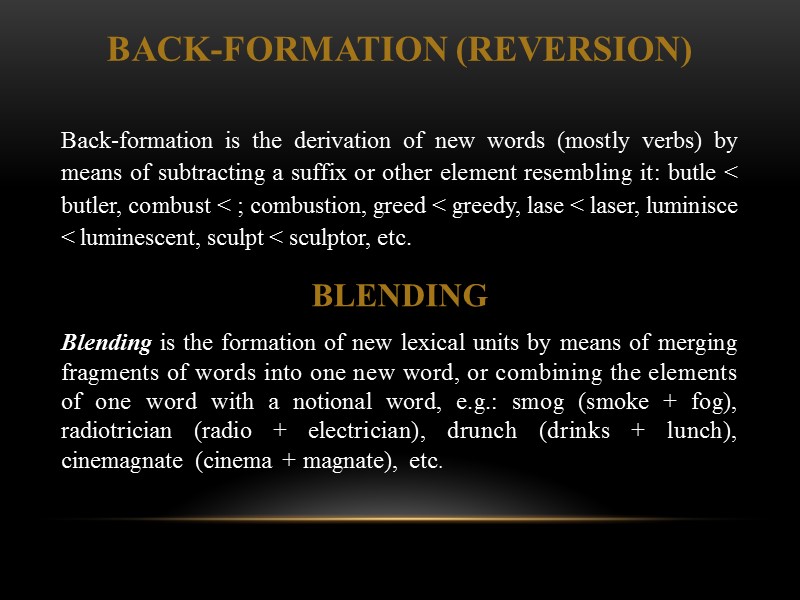
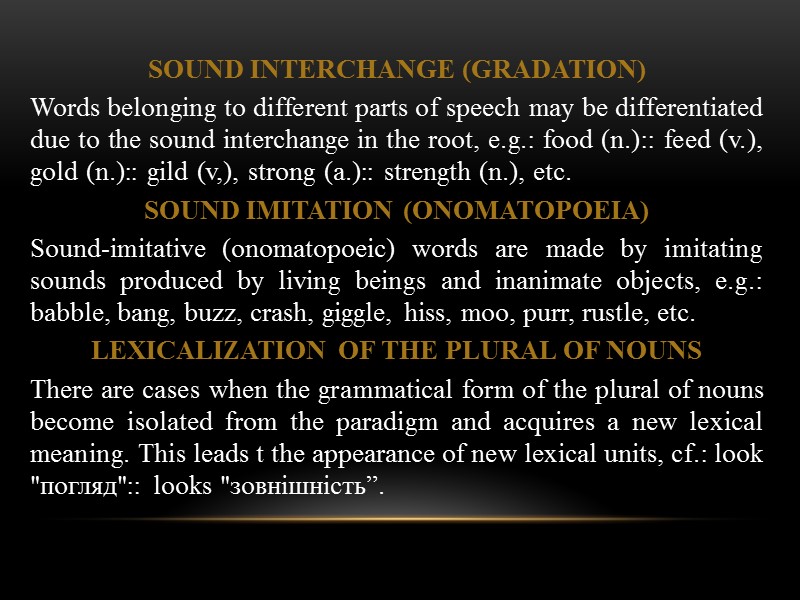
41204-word-formation.ppt
- Количество слайдов: 17
 TYPES of WORD-FORMATION highly-productive (affixation, conversion and similar phenomena (e.g. substantivation), compounding, shortening, forming phrasal verbs); semi-productive (back-formation, blending, reduplication, lexicalization of the plural of nouns, sound-imitation); nonproductive (sound interchange, change of stress)
TYPES of WORD-FORMATION highly-productive (affixation, conversion and similar phenomena (e.g. substantivation), compounding, shortening, forming phrasal verbs); semi-productive (back-formation, blending, reduplication, lexicalization of the plural of nouns, sound-imitation); nonproductive (sound interchange, change of stress)
 AFFIXATION Affixation is a word-formative process in which words are created by adding word-building affixes to stems. prefixation, i.e. forming new words with the help of prefixes; suffixation, i.e. forming new words with the help of suffixes.
AFFIXATION Affixation is a word-formative process in which words are created by adding word-building affixes to stems. prefixation, i.e. forming new words with the help of prefixes; suffixation, i.e. forming new words with the help of suffixes.
 Kinds of affixes I. From the etymological point of view: native (e.g. -er, -nese, -ing, un-, mis-, etc.) ; borrowed (Romanic: -tion, -ment, -ance, re-, sub-; Greek: e.g. -ist, -ism, anti-, etc.). II. According to the degrees of productivity: productive (e.g. -er, -ness, -able, -y, -ize, un-, re-, die-, etc.); non-productive (-th, -hood, -en, -ous, etc.). Types of suffixes noun-forming adjective-forming verb-forming adverb-forming
Kinds of affixes I. From the etymological point of view: native (e.g. -er, -nese, -ing, un-, mis-, etc.) ; borrowed (Romanic: -tion, -ment, -ance, re-, sub-; Greek: e.g. -ist, -ism, anti-, etc.). II. According to the degrees of productivity: productive (e.g. -er, -ness, -able, -y, -ize, un-, re-, die-, etc.); non-productive (-th, -hood, -en, -ous, etc.). Types of suffixes noun-forming adjective-forming verb-forming adverb-forming
 COMPOUNDING (COMPOSITION) Compounds are words produced by combining two or more stems which occur in the language as free forms. The classification of compounds According to the means of joining their IC's together: Juxtapositional (neutral) compounds whose ICs are merely placed one after another: classroom, timetable, heartache, whitewash, hunting-knife, weekend, grey-green, deep-blue, H-bomb; Morphological compounds whose ICs are joined together with a vowel or a consonant as a linking element, e.g.: gasometer, handicraft, electromotive, Anglo-Saxon, sportsman, saleswoman; Syntactic compounds (integrated phrases) which are the result of the process of semantic isolation and structural integration of free word-groups, e.g.: blackboard (
COMPOUNDING (COMPOSITION) Compounds are words produced by combining two or more stems which occur in the language as free forms. The classification of compounds According to the means of joining their IC's together: Juxtapositional (neutral) compounds whose ICs are merely placed one after another: classroom, timetable, heartache, whitewash, hunting-knife, weekend, grey-green, deep-blue, H-bomb; Morphological compounds whose ICs are joined together with a vowel or a consonant as a linking element, e.g.: gasometer, handicraft, electromotive, Anglo-Saxon, sportsman, saleswoman; Syntactic compounds (integrated phrases) which are the result of the process of semantic isolation and structural integration of free word-groups, e.g.: blackboard (
 II. According to the structure of their ICs: Compounds consisting of simple stems: railway, key-board, snow-white, bookshelf, scarecrow, browbeat, etc. Compounds where at least one of the ICs is a derived stem: chain-smoker, shoe-maker, pen-holder, snow-covered, moon-lit, price-reduction, etc. Compounds where at least one of the ICs is a clipped stem: Photo-intelligence, bacco-box, maths-mistress, T-shirt, TV-set, X-mas, etc. Compounds where at least one of the ICs is a compound stem: wastepaper-basket, newspaper-ownership, etc. Derivational compounds in which the second component does not occur as a free form. They are built by adding a suffix to phrases of the A+N, N + N, Num + N type: chain-smoker (n + (v + -er)) :: honeymooner ((n + n) + -er); snow-covered (n + (v + -ed)):: slim-waisted ((a + n) + -ed).
II. According to the structure of their ICs: Compounds consisting of simple stems: railway, key-board, snow-white, bookshelf, scarecrow, browbeat, etc. Compounds where at least one of the ICs is a derived stem: chain-smoker, shoe-maker, pen-holder, snow-covered, moon-lit, price-reduction, etc. Compounds where at least one of the ICs is a clipped stem: Photo-intelligence, bacco-box, maths-mistress, T-shirt, TV-set, X-mas, etc. Compounds where at least one of the ICs is a compound stem: wastepaper-basket, newspaper-ownership, etc. Derivational compounds in which the second component does not occur as a free form. They are built by adding a suffix to phrases of the A+N, N + N, Num + N type: chain-smoker (n + (v + -er)) :: honeymooner ((n + n) + -er); snow-covered (n + (v + -ed)):: slim-waisted ((a + n) + -ed).
 III. According to the function: Compound nouns patterns: N+N (e.g. night-club, airhostess (the most productive); Adj + N (e.g. deadline, sweet-heart, etc.) V + N (e.g. push-cart, fly-wheel, etc.) Ving + N (e.g. living room, blotting paper); N + V-ing (e.g. law-breaking, horseracing). Compound adjectives patterns: N + A (e.g. show-white, sky-blue); A + A (e.g. red-hot, social linguistic); A + N-ed (e.g. long-legged, navy-eyed); N + V-ed (e.g. crisis-ridden, hand-made) N/A/Adv/Pron + V-ing (e.g. peace-making, joy-causing, easy-going, ever-lasting, self-denying) Compound adverbs, pronouns, connectives are represented by an insignificant number of words (e.g. anything, inside, upright, somebody, otherwise, moreover, elsewhere, by means of, etc.)
III. According to the function: Compound nouns patterns: N+N (e.g. night-club, airhostess (the most productive); Adj + N (e.g. deadline, sweet-heart, etc.) V + N (e.g. push-cart, fly-wheel, etc.) Ving + N (e.g. living room, blotting paper); N + V-ing (e.g. law-breaking, horseracing). Compound adjectives patterns: N + A (e.g. show-white, sky-blue); A + A (e.g. red-hot, social linguistic); A + N-ed (e.g. long-legged, navy-eyed); N + V-ed (e.g. crisis-ridden, hand-made) N/A/Adv/Pron + V-ing (e.g. peace-making, joy-causing, easy-going, ever-lasting, self-denying) Compound adverbs, pronouns, connectives are represented by an insignificant number of words (e.g. anything, inside, upright, somebody, otherwise, moreover, elsewhere, by means of, etc.)
 IV. According to the semantics: Non-idiomatic - the meaning is easily understood from the meanings of their ICs, e.g.: dining-room, blood-pressure, plum-pudding, skiing-suit, raincoat, bookshelf, etc. Idiomatic compounds - the meaning of the unit cannot be understood from the meanings of its ICs, e.g.; buttercup, lady-killer, wall-flower, fiddlesticks, bull's-eye, jelly-fish, forget-me-not, hole-in-the-wall, etc.
IV. According to the semantics: Non-idiomatic - the meaning is easily understood from the meanings of their ICs, e.g.: dining-room, blood-pressure, plum-pudding, skiing-suit, raincoat, bookshelf, etc. Idiomatic compounds - the meaning of the unit cannot be understood from the meanings of its ICs, e.g.; buttercup, lady-killer, wall-flower, fiddlesticks, bull's-eye, jelly-fish, forget-me-not, hole-in-the-wall, etc.
 REDUPLICATION In reduplication compounds are made by doubling a stem (often a pseudo-morpheme). Subgroups of reduplicative compounds Reduplicative compounds proper whose ICs are identical in their form, e.g.: murmur, bye-bye, blah-blah, pooh-pooh, goody-goody, etc. Ablaut (gradational) compounds whose ICs have different root-vowels, e.g.: riff-raff, dilly-dally, ping-pong, chit-chat, singsong, etc. Rhyme compounds whose ICs are joined to rhyme, e.g.: willy-nilly, helter-skelter, hoity-toity, namby-pamby, walkie-talkie, etc.
REDUPLICATION In reduplication compounds are made by doubling a stem (often a pseudo-morpheme). Subgroups of reduplicative compounds Reduplicative compounds proper whose ICs are identical in their form, e.g.: murmur, bye-bye, blah-blah, pooh-pooh, goody-goody, etc. Ablaut (gradational) compounds whose ICs have different root-vowels, e.g.: riff-raff, dilly-dally, ping-pong, chit-chat, singsong, etc. Rhyme compounds whose ICs are joined to rhyme, e.g.: willy-nilly, helter-skelter, hoity-toity, namby-pamby, walkie-talkie, etc.
 PHRASAL VERBS It is a combinations of a verb and adverb or a verb and preposition (or verb with both adverb and preposition). Types of phrasal verbs Non-idiomatic phrasal verbs retain their primary local meaning, e.g. come in, come out, come out of, take off, put down, etc. They may also have a kind of perfective colouring, e.g. add up, eat up, drink up, swallow up, rise up, etc. In idiomatic compounds meanings cannot be derived from their ICs: bring up - виховувати, bear out - підтверджувати, give in - піддаватися, fall out -сваритися, take in- обманювати, etc.
PHRASAL VERBS It is a combinations of a verb and adverb or a verb and preposition (or verb with both adverb and preposition). Types of phrasal verbs Non-idiomatic phrasal verbs retain their primary local meaning, e.g. come in, come out, come out of, take off, put down, etc. They may also have a kind of perfective colouring, e.g. add up, eat up, drink up, swallow up, rise up, etc. In idiomatic compounds meanings cannot be derived from their ICs: bring up - виховувати, bear out - підтверджувати, give in - піддаватися, fall out -сваритися, take in- обманювати, etc.
 CONVERSION It is a special type of affixless derivation where a newly-formed word acquires a paradigm and syntactic functions different from those of the original word. All parts of speech can be drawn into the word building process of conversion to a certain extent. are varied. The most widespread derivational patterns N → V, V → N, A → V.
CONVERSION It is a special type of affixless derivation where a newly-formed word acquires a paradigm and syntactic functions different from those of the original word. All parts of speech can be drawn into the word building process of conversion to a certain extent. are varied. The most widespread derivational patterns N → V, V → N, A → V.
 SUBSTANTIVATION It is the process in which adjectives (or participles) acquire the paradigm and syntactic functions of nouns. Types of substantivation: complete - often regarded as a pattern of conversion (A → N). Completely substantivized adjectives have the full paradigm of a noun, i.e. singular and plural case forms. (a conservative politician →a conservative, a convertible car →a convertible, the official, officials, etc.). partial - adjectives do not acquire the full paradigm of a noun. They fall into several structural-semantic groups:
SUBSTANTIVATION It is the process in which adjectives (or participles) acquire the paradigm and syntactic functions of nouns. Types of substantivation: complete - often regarded as a pattern of conversion (A → N). Completely substantivized adjectives have the full paradigm of a noun, i.e. singular and plural case forms. (a conservative politician →a conservative, a convertible car →a convertible, the official, officials, etc.). partial - adjectives do not acquire the full paradigm of a noun. They fall into several structural-semantic groups:
 Structural-semantic groups of partially substantivized adjectives (PSA) PSA or participles which are singular in form though plural in meaning. They are used with the definite article and denote a group or a class of people, e.g. the rich, the accused, the English, the blind, the living, etc.; PSA used mostly in the plural and denoting a group or a class of people, e.g. reds, greens, buffs, blues, etc.; PSA used mostly in the plural and denoting inanimate things, e.g. sweets, ancients, eatables, etc.; PSA presenting properties as substantive abstract notions, e.g. the good, the evil, the beautiful, the singular, etc.; PSA denoting languages, e.g. English, German, Ukrainian, Italian.
Structural-semantic groups of partially substantivized adjectives (PSA) PSA or participles which are singular in form though plural in meaning. They are used with the definite article and denote a group or a class of people, e.g. the rich, the accused, the English, the blind, the living, etc.; PSA used mostly in the plural and denoting a group or a class of people, e.g. reds, greens, buffs, blues, etc.; PSA used mostly in the plural and denoting inanimate things, e.g. sweets, ancients, eatables, etc.; PSA presenting properties as substantive abstract notions, e.g. the good, the evil, the beautiful, the singular, etc.; PSA denoting languages, e.g. English, German, Ukrainian, Italian.
 ADJECTIVIZATION Premodification of nouns by nouns is highly frequent in Modern English. Noun-adjuncts should not be considered as adjectives produced by means of conversion. Nevertheless, some nouns may undergo the process of adjectivization and function as attributes with idiomatic meanings, e.g.: coffee-table (n.) →coffee-table (adj.) - "Of a large size and richly illustrated. PHRASAL NOUNS Phrasal nouns are built from phrasal verbs as a result of a combined effect of compounding, conversion, and change of stress. They consist of ICs identical to those of the corresponding phrasal verbs, but obtain, as a rule, the single-stress pattern and either solid or hyphenated spelling, e.g.: to break down → a breakdown (a break-down).
ADJECTIVIZATION Premodification of nouns by nouns is highly frequent in Modern English. Noun-adjuncts should not be considered as adjectives produced by means of conversion. Nevertheless, some nouns may undergo the process of adjectivization and function as attributes with idiomatic meanings, e.g.: coffee-table (n.) →coffee-table (adj.) - "Of a large size and richly illustrated. PHRASAL NOUNS Phrasal nouns are built from phrasal verbs as a result of a combined effect of compounding, conversion, and change of stress. They consist of ICs identical to those of the corresponding phrasal verbs, but obtain, as a rule, the single-stress pattern and either solid or hyphenated spelling, e.g.: to break down → a breakdown (a break-down).
 SHORTENING Ways of shortening: contraction (clipping) and abbreviation (initial shortening). Contraction Final clipping (apocope), i.e. omission of the final part of the word, e.g.: doc (
SHORTENING Ways of shortening: contraction (clipping) and abbreviation (initial shortening). Contraction Final clipping (apocope), i.e. omission of the final part of the word, e.g.: doc (
 ABBREVIATION Abbreviations (initial shortenings) are words produced by shortening the ICs of phrasal terms up to their initial letters. Groups of abbreviations Acronyms which are read in accordance with the rules of orthoepy as though they were ordinary words, e.g.: UNO /'ju:nou/ ( < United Nations Organization), UNESCO /'ju:'neskou/ (< United Nations Educational Scientific and Cultural Organization/, NATO /'neitou/ ( < North Atlantic Treaty Organization), etc. Alphabetic abbreviations in which letters get their full alphabetic pronunciation and a full stress, e.g.: USA /'ju:es'ei/ (< the United States of America), B.B.C. /'bi:'bi:'si:/ (< the British Broadcasting Corporation), M.P. /'em'pi:/ (< Member of Parliament), FBI /'ef'bi:'ai/ (< Federal Bureau of Investigation), etc. They are sometimes used for famous persons' names, e.g.: F.D.R. ( < Franklin Delano Roosevelt), G.B.S. (< George Bernard Shaw), B.B. (< Brigitte Bardot), etc. Compound abbreviations in which the first IC is a letter (letters) and the second a complete word, e.g. A-bomb (< atomic bomb), V-day (< Victory day), Z-hour (< zero hour), L-driver (learner-driver), etc. One or both ICs of compound abbreviations may be clipped, e.g.: mid-August, Interpol (< International police), hi-fi (< high fidelity), sci-fic (< science fiction), etc. Graphic abbreviations which are used in texts for economy of space. They are pronounced as the corresponding unabbreviated words, e.g.: Mr. (
ABBREVIATION Abbreviations (initial shortenings) are words produced by shortening the ICs of phrasal terms up to their initial letters. Groups of abbreviations Acronyms which are read in accordance with the rules of orthoepy as though they were ordinary words, e.g.: UNO /'ju:nou/ ( < United Nations Organization), UNESCO /'ju:'neskou/ (< United Nations Educational Scientific and Cultural Organization/, NATO /'neitou/ ( < North Atlantic Treaty Organization), etc. Alphabetic abbreviations in which letters get their full alphabetic pronunciation and a full stress, e.g.: USA /'ju:es'ei/ (< the United States of America), B.B.C. /'bi:'bi:'si:/ (< the British Broadcasting Corporation), M.P. /'em'pi:/ (< Member of Parliament), FBI /'ef'bi:'ai/ (< Federal Bureau of Investigation), etc. They are sometimes used for famous persons' names, e.g.: F.D.R. ( < Franklin Delano Roosevelt), G.B.S. (< George Bernard Shaw), B.B. (< Brigitte Bardot), etc. Compound abbreviations in which the first IC is a letter (letters) and the second a complete word, e.g. A-bomb (< atomic bomb), V-day (< Victory day), Z-hour (< zero hour), L-driver (learner-driver), etc. One or both ICs of compound abbreviations may be clipped, e.g.: mid-August, Interpol (< International police), hi-fi (< high fidelity), sci-fic (< science fiction), etc. Graphic abbreviations which are used in texts for economy of space. They are pronounced as the corresponding unabbreviated words, e.g.: Mr. (
 BACK-FORMATION (REVERSION) Back-formation is the derivation of new words (mostly verbs) by means of subtracting a suffix or other element resembling it: butle < butler, combust < ; combustion, greed < greedy, lase < laser, luminisce < luminescent, sculpt < sculptor, etc. BLENDING Blending is the formation of new lexical units by means of merging fragments of words into one new word, or combining the elements of one word with a notional word, e.g.: smog (smoke + fog), radiotrician (radio + electrician), drunch (drinks + lunch), cinemagnate (cinema + magnate), etc.
BACK-FORMATION (REVERSION) Back-formation is the derivation of new words (mostly verbs) by means of subtracting a suffix or other element resembling it: butle < butler, combust < ; combustion, greed < greedy, lase < laser, luminisce < luminescent, sculpt < sculptor, etc. BLENDING Blending is the formation of new lexical units by means of merging fragments of words into one new word, or combining the elements of one word with a notional word, e.g.: smog (smoke + fog), radiotrician (radio + electrician), drunch (drinks + lunch), cinemagnate (cinema + magnate), etc.
 SOUND INTERCHANGE (GRADATION) Words belonging to different parts of speech may be differentiated due to the sound interchange in the root, e.g.: food (n.):: feed (v.), gold (n.):: gild (v,), strong (a.):: strength (n.), etc. SOUND IMITATION (ONOMATOPOEIA) Sound-imitative (onomatopoeic) words are made by imitating sounds produced by living beings and inanimate objects, e.g.: babble, bang, buzz, crash, giggle, hiss, moo, purr, rustle, etc. LEXICALIZATION OF THE PLURAL OF NOUNS There are cases when the grammatical form of the plural of nouns become isolated from the paradigm and acquires a new lexical meaning. This leads t the appearance of new lexical units, cf.: look "погляд":: looks "зовнішність”.
SOUND INTERCHANGE (GRADATION) Words belonging to different parts of speech may be differentiated due to the sound interchange in the root, e.g.: food (n.):: feed (v.), gold (n.):: gild (v,), strong (a.):: strength (n.), etc. SOUND IMITATION (ONOMATOPOEIA) Sound-imitative (onomatopoeic) words are made by imitating sounds produced by living beings and inanimate objects, e.g.: babble, bang, buzz, crash, giggle, hiss, moo, purr, rustle, etc. LEXICALIZATION OF THE PLURAL OF NOUNS There are cases when the grammatical form of the plural of nouns become isolated from the paradigm and acquires a new lexical meaning. This leads t the appearance of new lexical units, cf.: look "погляд":: looks "зовнішність”.

